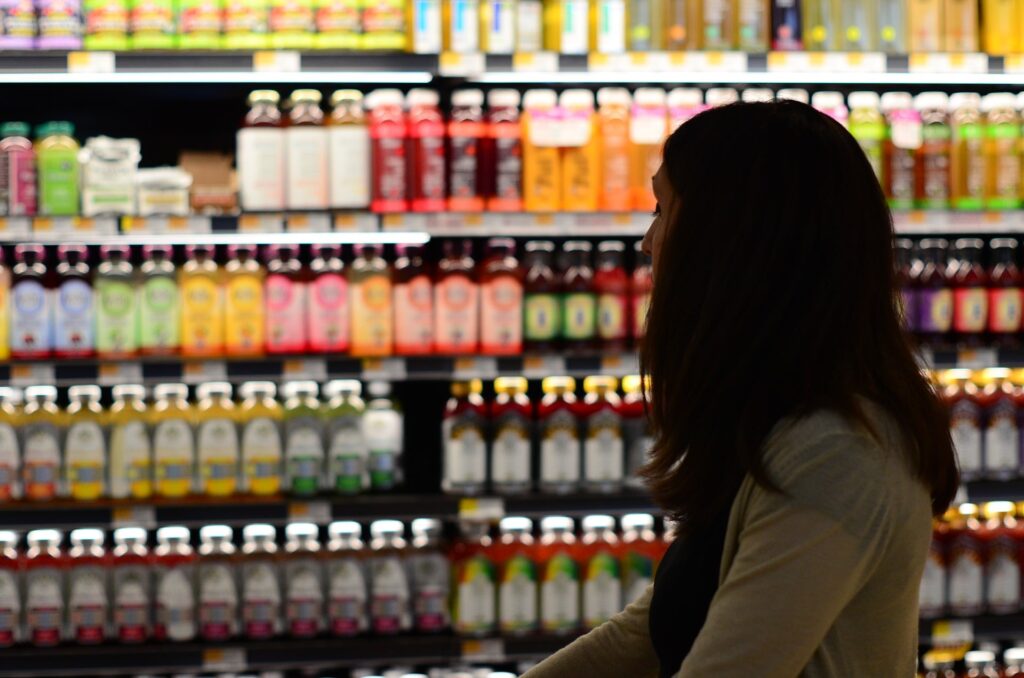Although it’s a hot topic, in-store advertising is not a new or rare practice. Consumer packaged goods (CPG) brands do it all the time since retail spaces are often the best locations for them to grow. Typically this is done by negotiating the best spot on the shelf or by putting up in-store displays and ads. However, it is becoming more common for brands to advertise in-store using mobile apps.
 These apps can interact with beacons within a retail location, delivering offers to the consumer once they are within a certain proximity to the store, working in accordance with GPS tracking. This is particularly effective since 59% of consumers are using their mobile devices while they’re out doing their weekly grocery shopping.
These apps can interact with beacons within a retail location, delivering offers to the consumer once they are within a certain proximity to the store, working in accordance with GPS tracking. This is particularly effective since 59% of consumers are using their mobile devices while they’re out doing their weekly grocery shopping.
While advertising through a mobile app offers a direct line to the customer, it still needs to effectively grab their attention. Brands must find ways to leverage in-store experiences to get consumers interested in trying their products. Finding a unique slant on this is paramount to creating a successful campaign. Luckily, more than a few brands have built effective conversion strategies and have created unique experiences that you can use with your in-store mobile marketing plans.
How Top Brands Leverage In-Store Mobile Advertising
In-store mobile-based marketing is a relatively new marketing avenue, so many brands are approaching this medium with pilots. In-store events, advertisements, and offers have been developed by many different brands with varying levels of success. Additionally, in-store beacon technology is enabling these campaigns to be more successful. These are some of the tactics that the most successful brands use to take advantage of these innovations:
- Exclusive location-based offers: One way that Best Buy drove adoption of its rewards program was by using it to push in-store mobile marketing offers. Consumers who downloaded the app would receive exclusive offers when they went to the store. Once they entered a store, they were also able to unlock rewards points that they could use on purchases and exclusive deals.
- Cross-marketing opportunities: Often, there are in-store marketing opportunities from advertising alongside related products. For example, if you set up a beacon that advertises creamer or sweetener near the coffee aisle, the consumer will have more incentive to purchase it. The consumer may have come into the store to purchase a specific item, but now their app has enticed them to purchase additional products.
- In-store engagement: One thing that can really get consumers involved in-store is to get them to play games or interact with the brand via their mobile device. Ace Hardware does this through in-store sites where consumers are encouraged to text a phrase to them, at which point they receive an offer in return. Their app engages consumers by acting as a virtual scavenger hunt, which can improve conversions.
Using in-store beacons to reach a customer on his or her mobile device increases the likelihood that consumers will try out a new brand. At the very least it drives brand recognition, as in-store mobile experiences are particularly memorable. This is because consumers are engaged in using the app, so they’re more likely to remember the brand than if they were just passively watching television or browsing a website. CPG brands can model their in-store campaigns after those that other successful brands use. This helps ensure that their in-store messages have a lasting impact.
Tips For Building An In-store Campaign
Several brands have already found unique ways to leverage in-store marketing through mobile apps—and more are catching on. Consumers are responding to it too. For example, 70% of consumers in the CPG-focused Mobile Audience Insights Report reported that they decided to purchase a product for the first time after viewing mobile-based advertising. That number has nearly doubled since 2013. Nearly 70% also reported using their mobile device to research a CPG brand prior to purchasing it at a retail location.
Mobile advertising is changing the way that consumers shop, which is why you should change the way you leverage mobile in-store apps. That means creating a campaign that encompasses the following:
- A value-driven approach: Value-driven doesn’t necessarily mean discounts. Instead, it means that the message gives the consumer something, whether it’s a reward, information or simply an enjoyable experience. Basic advertisements have large impacts in-store, but they are not long lasting. However, advertisements that engage the consumer by interacting with your brand tend to have a greater overall impact.
- Proper consumer targeting: In-store advertising still needs to be focused on specific consumers. Consider two different consumers that are shopping in the same store. One is purchasing diapers, baby formula, and wipes. The other is purchasing a frozen pizza and a two-liter bottle of soda. Those purchasing behaviors allow you to draw conclusions in order to properly target the right consumer. So, if your brand is selling disposable baby bottles, then the first consumer is your ideal target. If your brand is selling chips, on the other hand, you’d likely want to target that second consumer. An app with high conversion potential will give you the data you need to make decisions like that.
- Is not heavily focused on discounts: Simply offering one-time coupons via an app may get you a one-time sale, but it’s not a powerful brand converter. Relying too heavily on discounts is a mistake. This is because it generally only attracts price-conscious consumers. It can also lower the way your brand is perceived. In-store apps should leverage rewards rather than discounts as a way of gaining consumer attention.
Mobile in-store advertising is changing the way brands target and convert consumers. This type of advertising allows your brand to follow consumers through their purchase journey, reach them at the right moments, and increase the likelihood that they will try your brand. Several brands have already used this successfully by creating unique personalized and interactive campaigns that pull in users.
As beacon-based advertising technology and mobile geolocation are both relatively new, it’s best to choose to work with a company that already has some understanding of the industry.
One thing that these brands do is leverage partnerships with third-party experts who understand the unique opportunities presented by mobile apps. As beacon-based advertising technology and mobile geolocation are both relatively new, it’s best to choose to work with a company that already has some understanding of the industry. This is where third-party shopping apps come in.
Third-party shopping apps allow you to access these in-store marketing opportunities quickly, without having to create an expensive, long-tailed marketing campaign. These apps also give you access to a database of active users who want to connect with your brand. For any company that wants to make a stronger in-store impact through mobile marketing, third-party platforms are the ideal choice.
Shopkick is a unique shopping app that allows its partners to leverage all of the best parts of in-store mobile advertising. To work with us and increase your in-store conversion, contact our team today.
Image courtesy Pixabay user kc0uvb





